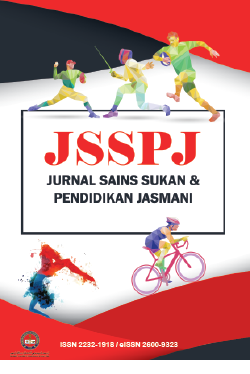Decoding Goal Scoring Dynamics in Men’s Football-A Comparative Analysis Towards Winning and Losing Teams During 2022 FIFA World Cup
DOI:
https://doi.org/10.37134/jsspj.vol12.2.5.2023Keywords:
Goal Scoring, Character, Performance Analysis, World Cup, Winning, LosingAbstract
This study examines the goal-scoring patterns of men's football teams during the 2022 FIFA World Cup, distinguishing between winners and losers. Using a non-experimental, cross-sectional design, a carefully selected sample of n=49 matches was analyzed after excluding uncertain outcomes. Various goal-scoring indicators (such as corner kicks, solo runs, headers, long shots, etc.) for winning and losing teams were investigated, with a significance level of p<0.05. Applying the Mann-Whitney U test, significant differences were found in solo runs between victorious (Md = 2.00) and defeated (Md = 1.00) teams (U = 672.5, z = -3.882, p < 0.01, r = 0.39). Winners averaged 1.90 ± 0.96 solo runs, compared to losers' 1.08 ± 1.16, a notable 0.82 difference. Similarly, headers also varied significantly between winning (Md = 3.00) and losing (Md = 2.00) teams (U = 688.5, z = -3.744, p < 0.01, r = 0.38). Winning teams averaged 2.92 ± 1.66 headers, surpassing losers' 1.86 ± 1.31, with a significant 1.06 difference. Solo runs were identified as vital for creating goal-scoring opportunities, while headers played a significant role in actualizing goals. Overall, the study emphasizes the importance of individual creativity (solo runs) in crafting chances and efficient titles in set-piece situations for successful goal-scoring strategies among winning teams.
Downloads
References
Aquino, R., Manechini, J. P., Bedo, B. L., Puggina, E. F., & Garganta, J. (2017). Effects of match situational variables on possession: The case of England Premier League season 2015/16. Motriz: Revista de Educação Física, 23. https://doi.org/10.1590/S1980-6574201700030015
Alberti, G., Iaia, F. M., Arcelli, E., Cavaggioni, L., & Rampinini, E. (2013). Goal scoring patterns in major European soccer leagues. Sport Sciences for Health, 9, 151-153. https://doi.org/10.1007/s11332-013-0154-9
Dufour, M., Phillips, J., & Ernwein, V. (2017). What makes the difference? Analysis of the 2014 World Cup. Journal of Human Sport and Exercise, 12(3), 616-629. https://doi.org/10.14198/jhse.2017.123.06
Fernandes, T., Camerino, O., Garganta, J., Hileno, R., & Barreira, D. (2020). How do elite soccer teams perform to ball recovery? Effects of tactical modelling and contextual variables on the defensive patterns of play. Journal of Human Kinetics, 73(1), 165-179. https://doi.org/10.2478/hukin-2019-0141
Hughes, M., & Churchill, S. (2005, May). Attacking profiles of successful and unsuccessful teams in Copa America 2001. In Science and football V: The proceedings of the fifth world congress on science and football (Vol. 23, No. 2, pp. 222-8).
Hughes, M., & Lovell, T. (2019). Transition to attack in elite soccer. Journal of Human Sport & Exercise, 14(1). https://doi.org/10.14198/jhse.2019.141.20
Kubayi, A., & Toriola, A. (2019). Trends of goal scoring patterns in soccer: A retrospective analysis of five successive FIFA World Cup tournaments. Journal of Human Kinetics, 69, 231. https://doi.org/10.2478/hukin‐2019‐0015
Kubayi, A. (2020). Analysis of goal scoring patterns in the 2018 FIFA World Cup. Journal of Human Kinetics, 71(1), 205-210. https://doi.org/10.2478/hukin-2019-0084
Liu, G., Luo, Y., Schulte, O., & Kharrat, T. (2020). Deep soccer analytics: learning an action-value function for evaluating soccer players. Data Mining and Knowledge Discovery, 34, 1531-1559. https://doi.org/10.1007/s10618-020-00705-9
Mitrotasios, M., Kubayi, A., Armatas, V., & Larkin, P. (2022). Analysis of crossing opportunities at the 2018 FIFA World Cup. Montenegrin Journal of Sports Science and Medicine, 11 (1), 43–52. https://doi.org/10.26773/mjssm.220305.
Njororai, W. W. S. (2013). Analysis of goals scored in the 2010 world cup soccer tournament held in South Africa. J. Phys. Educ. Sport, 13, 6–13. https://doi.org/10.7752/jpes.2013.01002.
Olvera-Rojas, M., Femia, P., & Castillo-Rodríguez, A.. (2021). Scoring first relevance in knockout promotion to Spanish LaLiga Smartbank. Journal of Human Sport and Exercise, 18(1): 11-20. https://doi.org/10.14198/jhse.2023.181.02
Paul, D. J., Bradley, P. S., & Nassis, G. P. (2015). Factors affecting match running performance of elite soccer players: shedding some light on the complexity. International Journal of Sports Physiology and Performance, 10(4), 516-519. https://doi.org/10.1123/ijspp.2015-0029
Pratas, J. M., Volossovitch, A., & Carita, A. I. (2018). Analysis of scoring sequences in matches of the Portuguese premier league. Journal of Human Kinetics, 64, 255. https://doi.org/10.1515/hukin-2017-0199.
Downloads
Published
Issue
Section
License
Copyright (c) 2023 Muhamad Aidil Faiz Ramdzan, Muhamad Noor Mohamed, Mardiana Mazaulan, Nurul Ain Abu Kasim, Raja Nurul Jannat Raja Hussein, Sharifah Maimunah Syed Mud Puad, Mohd Aizzat Adnan

This work is licensed under a Creative Commons Attribution-NonCommercial-ShareAlike 4.0 International License.





